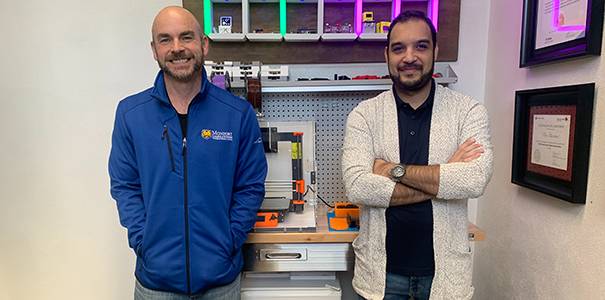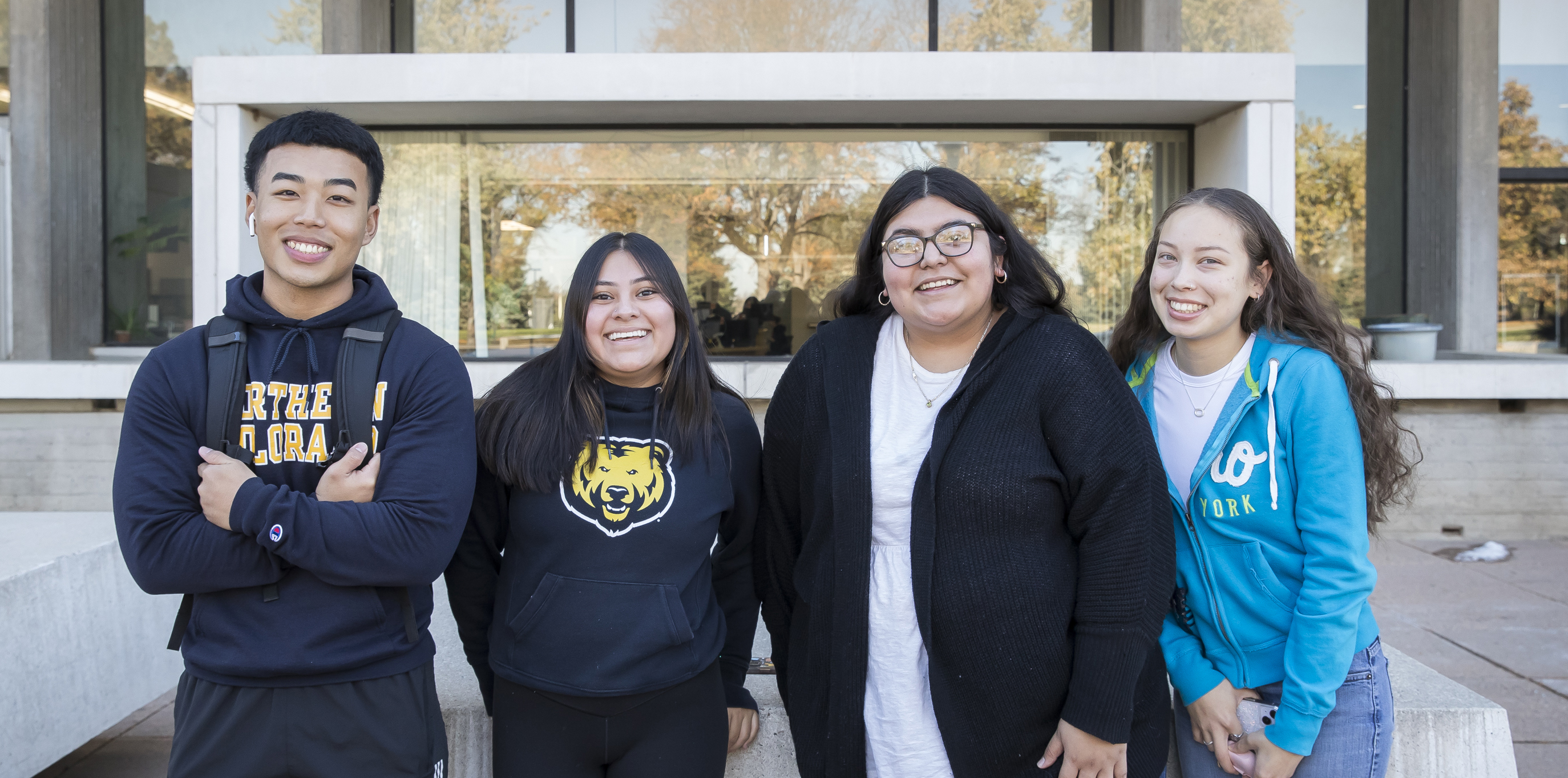
Above: UNC faculty members Daniel Brannon (left), Ph.D., and Moe Manshad (right), Ph.D.
It’s an easy habit to fall into. While watching TV or folding laundry, it’s almost second nature for many to pick up their phone, browse a retail site and before they know it, they’ve clicked ‘purchase’ multiple times. This became especially popular during the beginning of the pandemic when many were staying at home. Though online shopping is convenient, it can also be costly.
“People tend to overpay when they pay via mobile or online because it's kind of like a painless payment, you don’t have to pay with cash,” said Daniel Brannon, Ph.D., assistant professor of Marketing in the Monfort College of Business (MCB) at the University of Northern Colorado.
Brannon has been exploring theories surrounding online shopping and payment apps, specifically seeing if there is a way to help people not dip into their savings so quickly. It turns out there is.
Haptic Payment
Brannon and his college friend turned fellow UNC faculty member, Moe Manshad, Ph.D., found a way to hinder overspending online, even if just by a little, through a 3-D printed vibration motor controller attached to a phone.
“All mobile phones have vibrations that are used to deliver notifications to consumers, for example when you receive a like or comment on a social media post,” said Manshad, assistant professor of Computer Information Systems for MCB. “We wanted to see if receiving a similar vibration notification when you are in the act of paying for something with your mobile device could affect how consumers feel about their spending on these devices.”
In traditional, in-person shopping, consumers experience the physical aspect of standing in line or taking a form of payment out of their wallet, which research shows can lead to a sense of loss. Online shopping removes that, which is why the pair looked for a different way to bring out that emotion.
“We wanted to see whether high or low haptic vibration intensity was most likely to elicit a sort of pain of payment,” Brannon said.
Through the experiment, the faculty members discovered haptic vibrations may work. Haptic technology uses vibrations and motors to simulate the feeling of touch.
The first step was creating a device, which Manshad was able to do using a 3-D printer located in his office. He then developed a mobile app that connected to a microcontroller with a vibration motor and hooked that onto the back of a phone.

“One of the things that we worked on is developing the device that basically gives us control of the haptic part of the phone. Traditionally, on older phones, you don't have much control over the intensity of vibration, so we had to build a device,” Manshad said.
Using the device, the professors then sought out a sample of 160 undergraduate students to participate in the experiment. In the basement of MCB, a shopping experience was set up where each student chose from a shelf of various potato chips, used a mobile payment app to scan the QR code and then pressed ‘purchase’ in the app. Upon pressing the purchase button, the students received either low-intensity, high-intensity, or no vibration feedback. They were then asked how much money they were willing to spend on a subsequent shopping trip.
Above: Moe Manshad, Ph.D., explains how the app and vibration motor he created for the experiment works
Those who experienced a low-intensity vibration said they would spend less.
“There’s a theory in psychology that low-frequency stimuli like low-frequency sounds can cause a sense of threat or danger,” Brannon said. “If you think about a scary movie a lot of times it’s that low, eerie sense that people get. It gives a sinister feeling.”
Manshad says high frequency tends to have the opposite effect.
“High intensity is more associated with excitement or positivity to some extent,” Manshad said.
Specifically, the research showed on a scale from $1-$100, the students who received a low-intensity vibration after pressing purchase were willing to spend an average of $41.37 on their next grocery trip compared to an average of $50.65 that students who experienced high-intensity vibrations said they were willing to spend.
“What we’re theorizing is that people who got the lower-intensity vibration tended to experience a bit more negative emotion, and subsequently they were less likely to spend,” Brannon said.
While the findings that could help consumers save a couple of dollars while online shopping excite Brannon and Manshad, they know similar future experiments can provide more bang to the buck for their UNC students.
Student Involvement
“I was walking through the Monfort College of Business basement and saw a couple of professors setting up this cool experiment, and they asked if I wanted to participate in a five-minute survey,” said Cara Quinn.
Quinn, now in her fifth year at UNC was one of the students selected to participate in the mobile payment experiment. She was placed in the category of students who received no haptic vibration feedback after 'purchasing' a bag of chips on an iPhone.
“It was great to see my professors working on an experiment and that they have their own research that they’re doing outside of teaching,” Quinn said.
As a Marketing major, Quinn has learned under Brannon frequently and has recently taken advantage of Manshad’s expertise picking up computer information systems (CIS) courses for her minor in Digital Marketing. She says though Marketing and CIS seem vastly different, she's learned the disciplines often overlap.
“They all relate to each other. Things I’ve learned in CIS I can implement into my digital marketing, especially with coding,” Quinn said.
That is what Brannon and Manshad want to focus on moving forward.
“What we want to do is enable students to understand and create interactive systems or interfaces in some capacity. We try to showcase and apply a multi-experience that can apply to marketing, software engineering, computer information systems (CIS), accounting and beyond,” Manshad said.
Multiexperience Lab
MCB already excels in offering a unique in-house software engineering program, but Manshad and Brannon want to take it a step further.
“We want to bring in marketing students to research and hold focus groups and have CIS students learn about the business process behind the development,” said Manshad.
There are plans and funds available to expand research tools at MCB. For example, Manshad has already received three more 3-D printers for a total of five that students can use. With that, Brannon and Manshad are developing a Multiexperience (MX) Lab.
Above: One of five 3-D printers available for students to use inside the Monfort College of Business
“We're looking at starting up programs and courses within the university, or within the business school, that utilize the lab as part of the curriculum,” Brannon said. “Students would have to learn basic programming, as in how to create interfaces for apps and how to do basic prototyping.”
The goal is to launch a one-or two-part class in the next one to two years.
“With the MX Lab, using it for teaching and getting research out, students won’t only be there for class but also to test technology,” Brannon said.
The lab will enhance students’ education at UNC supporting critical inquiry, discovery and creation, and provide career-ready experience.
“At the end of the day, each student needs value from each class to put on their resume,” Manshad said. “We’re showing our students that we, as faculty, are up to date with industry standards. We know how to use the technology involved and we can teach them these tools so that they have experience when interviewing for a job.”
So, for example, if an employer asks Quinn if she has any experience in surveying a product, say an app that provides vibration when purchasing an item online, she’ll be able to give a quick “yes.”
Brannon and Manshad’s research is published in the Journal of Business Research in the article entitled “Haptic-payment: Exploring vibration feedback as a means of reducing overspending in mobile payment.”
- Written by Sydney Kern
More Stories
-
Governor Polis Reappoints Two to UNC’s Board of Trustees
Este artículo no está en español.
-
State Farm Invests in Career Readiness Initiatives for UNC Students
Este artículo no está en español.
-
Commentary: The Importance of Investing in First-Generation Students
Este artículo no está en español.
-
Supporting First-Generation College Students to Become Next-Generation Leaders
Este artículo no está en español.




